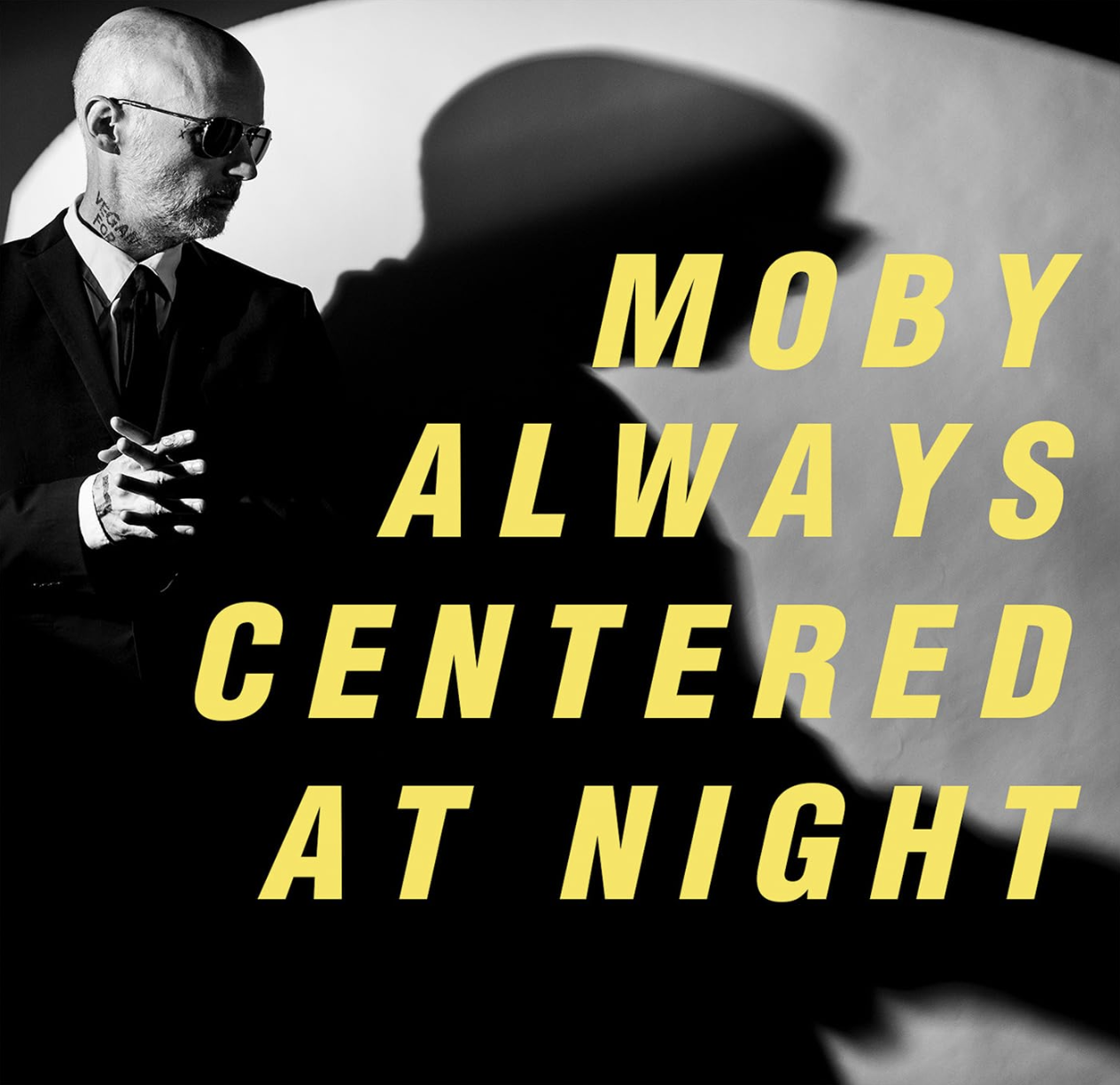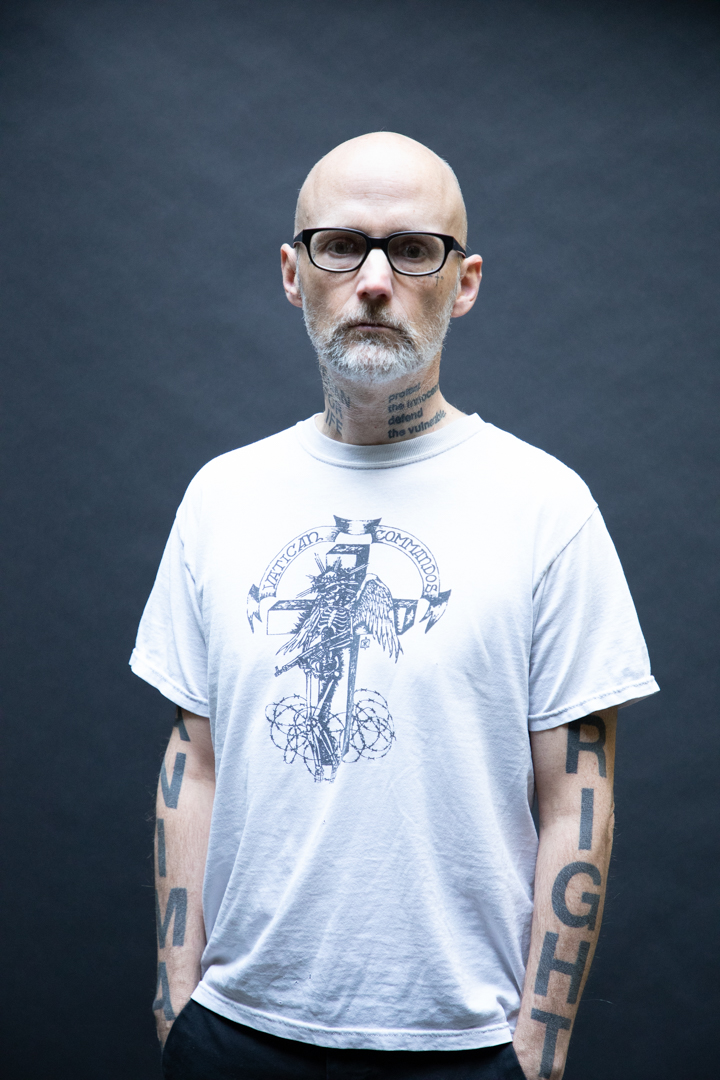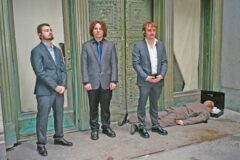How strange it must have been for Moby to spend a decade making electronic music that moved dance floors globally, then punk rock that was met with revulsion, then an album that resonated so strongly across the world that it catapulted him, the unlikeliest of superstars, into the stratosphere.
That multi-platinum album, Play, marks its 25th anniversary this year, and it is still the best-selling electronic dance music album of all time. To mark the occasion, as well as the release of his latest album, Always Centered at Night, Moby hosted a special two-night event at Los Angeles’ historic Masonic Lodge located in the Hollywood Forever Cemetery, for a live taping of his podcast, Moby Pod, at the end of May.
Over the course of the two evenings, Moby shared humorous (and sometimes unsettling) tales about his life before and after Play. Interspersed through his anecdotes were stunning acoustic performances of material from Play and Always Centered at Night.


Moby was joined by his podcast co-host Lindsay Hicks for the narrative portion—and he mentioned SPIN was the only magazine that gave Play a nice mention upon its release, which was otherwise dismissed out of hand. Speaking particularly about his life after Play, Moby was painfully and brutally honest about using external validation to fix trauma and insecurity. He spoke about using alcohol, drugs, touring and fame to overcome his feelings of inadequacy. He admitted frankly to discovering cocaine after seeing Donna Summer and consuming 20 to 25 drinks a night on a regular basis, making vodka smoothies. He called it “nihilism and hedonism wrapped up.”
For the performance portion, Moby’s four superb vocalists (Julie Mintz, Laura Dawn, Nadia Duggin, and Choklate, the latter of whom is featured on Always Centered at Night track “sweet moon”) joined him, as well as cellist Maya Paredes and violinist Andrea Whitt. Lady Blackbird, another Always Centered at Night collaborator, made a special appearance to sing their song, “dark days.”
These poignant renditions brought new life to Moby’s familiar songs. The songs shined broken down to their spare elements, bringing the rapt audience close to tears. By the end of the second evening, Moby pointed out that, at almost three hours from the start of the taping, it was the longest show of his life.
While music and veganism are perhaps the two things he is most known for, the well-read and well-rounded Moby has countless interests, among them architecture. Here he lists his 10 most essential modern architecture buildings.
Sorry to start with something so obvious, but it really is one of the most remarkable buildings/houses/Aztec spaceships from the 20th century. And, if you think you haven’t seen it, well, you have. Is it modern? Yes, but… Is it a crashed spaceship from spacefaring Aztecs? Also yes, but… lastly, and creepily, it’s possibly where George Hodel buried the bodies of his surrealist serial killing victims.
OK, you’ve seen this in pictures, in sketches, but in person it defies any and all rules of physics, aesthetics, logic, and humanity. I’m glad it’s there, and I’m glad that [architect and designer] Eero Saarinen was a genius, but in person it simply seems like it shouldn’t exist. It’s delicate and flimsy, but also neither. It’s not just one of the greatest structures of the 20th century, but it’s near the top of the list of ridiculous and remarkable things that humans have ever built.
My admission here is that I haven’t seen Michael Heizer’s City up close and in person because, well, almost no one has. It’s very, very far away. Remote. Hidden on a different planet (Nevada). But Michael Heizer is my second favorite artist of the 20th century after Marcel Duchamp. The pictures I’ve seen of his city make me uncomfortable in the best way, as his work points at not just yours and my insignificance, but also the deep insignificance of our weak little species.
New York, to state the obvious, has a lot of buildings and a lot of amazing buildings. Many, like Lever House, are pristine and beautiful examples of mid-century commerce. Others, like the Woolworth Building, are towering metal pencils, but also examples of thrusting commerce. What makes the Tribeca Synagogue so remarkable is that it’s cryptic and understated and almost offensive but also sinuous in a way that gray flowing brutalism shouldn’t be.
Every city has its one iconic building. Rome has the Coliseum. London has Big Ben. NYC has the Empire State Building. And L.A. has the Griffith Observatory. It’s not just a spectacular—and spectacularly sited—building, but it’s a beautiful, absurd metaphor. Most cities have iconic temples of commerce or government or structure. Griffith Observatory is a functioning observatory built to look at the stars through, at times, impenetrable light and atmospheric pollution. It’s naive and grand and playful and fantastically pointless, kind of like my adopted town of Los Angeles itself.


:
Is a crater a building? OK, yes. Also how fantastic that there are two humongous land-art crazy… buildings (Cities? Landing strips?) in the west? Michael Heizer’s City and James Turrell’s Crater. It’s also interesting that Michael Heizer works largely in the relatively permanent stone, whereas James Turrell works in the relatively impermanent—light. Both are remarkable, as artists, and as people who build beautiful monstrosities in the desert.
You’ve seen this too. In fact in The Simpsons it’s where Troy McClure lives with his romantic fish partners. When I first moved to Los Angeles, I had dinner at the Chemosphere with Tadao Ando (him next in the list), and I was standing with him at the railing looking at the valley and the mountains and I thought, “OK, Los Angeles is strange and great and collapsing and beautiful, and I guess it’s home now.”
Tadao Ando, Museum for Wood Culture
To be fair, this list should just be 10 buildings by Tadao Ando, but I can only pick one, and it’s the Museum for Wood Culture. Not just because it’s Tadao Ando, the greatest living architect, but because it’s a museum inspired by trees and wood. Tadao Ando is basically a poet. I know that sounds like gentle hallmark hyperbole, but it’s true. His work takes my breath away, no matter where or what it is.
Some architects build buildings. But look over here, there’s Oscar Niemeyer, and he built an entire city. The last time I was in Brazil, I actually scheduled a show in Brasília just so I could see Oscar Niemeyer’s city up close—and it didn’t disappoint, not at all. It’s utopian and odd and beautiful and unwelcoming and futuristic and kind of crumbling. It’s perfect, just like all of his buildings.
Ludwig Mies van der Rohe, Farnsworth House
Ending with the obvious and the understated. Mies is the godfather of 20th century architecture, and to not include him in a list of greatest modern “buildings” would be like a list of best electronic music that didn’t include Donna Summer’s “I Feel Love.” The Farnsworth House, unlike the Seagram Building, is just poetry in right angles. It’s so understated and surprisingly small and humble (and happily restored after being flooded). I could include a few thousand other phenomenal buildings and architects, but I’ll leave it with Mies, as he kind of started the whole thing in the early 20th century.

